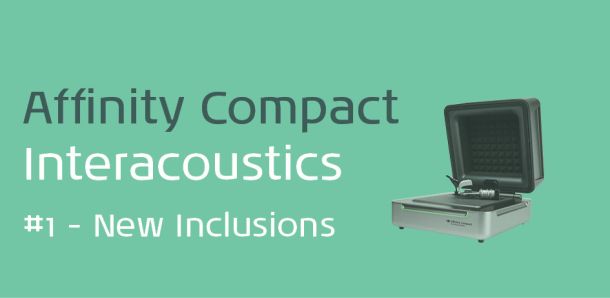Tips and Tricks for obtaining the best VEMP results on the Interacoustics Eclipse
Vestibular Myogenic Potentials testing, VEMP's, can be a valuable addition to the vestibular test battery. If you are new to VEMP's or need a refresher, webinars are available on our website as an introduction to VEMP testing. Links below to get your started:
There are also other webinars for VEMP on the Academy page of our website under “Tutorials” and “Webinars and Presentations”.
The VEMP module on the Eclipse includes both cervical VEMP (cVEMP) and ocular VEMP (oVEMP) protocols.
Here are some general tips with obtaining good VEMP results:
-
- Ensure that the electrode gel has not dried out and it is within the expiry date. We recommend using the Ambu Neuroline 720 for best results from Sanibel Supply.
- Ensure good preparation of electrode site on skin for good impedance results.
- Transducer cables should be placed away from the Pre-amp.
- Transducer and electrode cables should also not be near each other
- Minimise electrical interference in the room by switching off lights, phones, electric bed and other equipment that does not need to be on in the room
- Keep the patient’s head away from the wall as electrical mains can be an issue.
cVEMP
The recommended electrode configuration is shown below. For the best result, the reference electrodes right and left should be placed on the upper belly of the sternocleidomastoid muscle (SCM) on both sides in line with each other.

-
To activate the SCM the patient can either be seated and turn their head to the opposite side or can be reclined and lift head with head turned as well. Sometimes, to get better activation you can point the chin downwards towards opposite shoulder.
To ensure that SCM’s effort on both sides is equal, use the EMG monitor on the screen as a guide. You can apply EMG scaling which compares the vestibular response rather than neck effort. EMG scaling scales the waveforms according to average pre stimulus EMG.
Most cVEMP analyses relies on comparing both sides, so set VEMP partners. You can only compare partners of the same stimulus type and level.
Protocol parameters for cVEMP in the Eclipse are optimal on the default setting.
An example of a normal cVEMP result :-
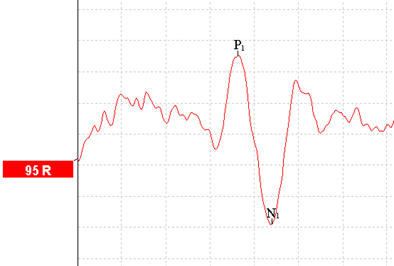

cVEMP Norms:
Latency: P1 approx 16ms (Toneburst) approx. 13ms (Click)
N1 approx 25ms (Toneburst) approx. 23ms (Click)
Amplitude: 50-300 uV (Much larger than an ABR)
Asymmetry: >36 % (Young et al 20021) When using both EMG monitoring and scaling the upper limit of normal is approx. 31-37 % (McCaslin et al 20132)
oVEMP:
We recommend the electrode configuration as below. Avoid the lower eyelid placement too close to inner corner of the eye (medial canthus) as there is a null point in this area, giving no response. If you have no response from oVEMP – check this placement as incorrect placement of the electrodes under the eyes can make a difference in the results achieved.
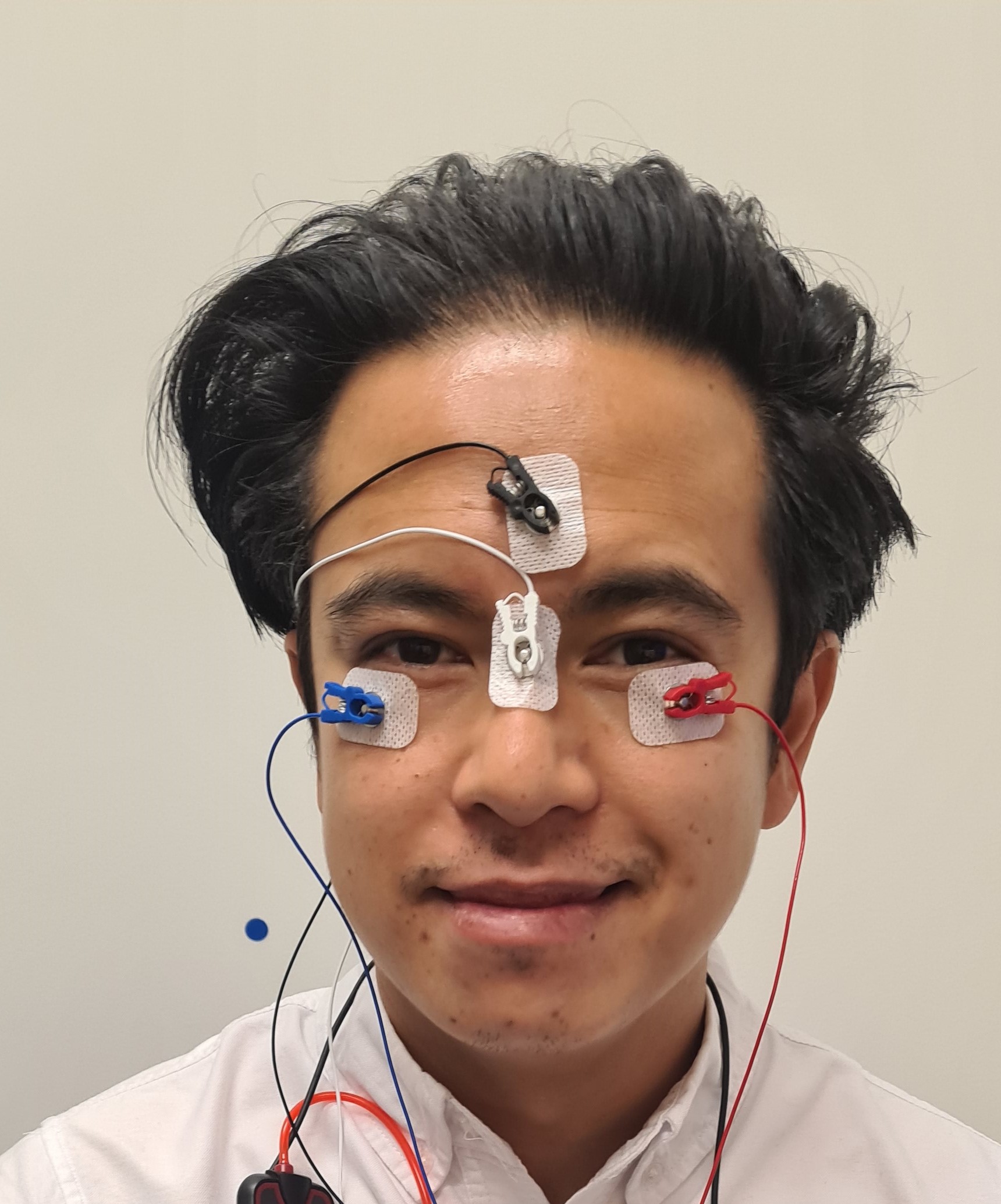 Here is Trong demonstrating the correct placement
Here is Trong demonstrating the correct placement -
Also be aware that when testing the left ear for example, the recording is from contralateral side (blue electrode under right eye) as it is a stronger response.

-
For oVEMP's a B81 bone conductor is required as the B71 is not strong enough.
Instruct the patient to look up 30-35 deg. Put a marker on the wall/ceiling for the patient to look at so that they are looking at same point when testing left v’s right ears.
Comments for oVEMP : Check position of electrodes under the eyes, Finger on BC so it doesn’t bounce off skin when presenting. Use hide stimulus artefact by right clicking on the curve. It helps smooth out the beginning of the curve where BC artefact can occur. Change the rise/fall time, and plateau so that signal comes on quick, sustained and off really quick. Reduces transducer artefact
EMG monitor is displayed in this test but does not have any function. You do not need EMG scaling.
Need approximately 160-200 sweeps for oVEMP
Expect a large artefact at the start of the response due to the bone conductor. Ways to reduce this artefact are :-
- Place the pre-amp on opposite side of head to where BC is
- Due to higher intensities, hold the BC against the skin, it can stop it from bouncing and causing artefacts.
- use the “hide stimulus artefact“ by right clicking on curve. This helps smooth our the curve at the beginning of the response.
- With oVEMPs - the rise/fall time and plateau should be changed in the default protocols to help with the interference from the BC artefacts. Go into File -> System setup - > Auto protocols and change to settings below.

Protocol parameters for the oVEMP on the Eclipse are optimal on the default setting, except for the rise/fall and plateau times – change as above.
Here is an example of a normal oVEMP:
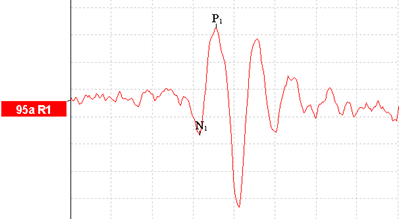
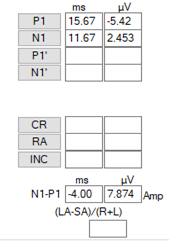
-
oVEMP norms:
oVEMP is typically a small response 4-15 uV.
N1 – approx. 10ms
P1 – approx. 15ms
Threshold which is 80dB and above.
Asymmetry ratio: abnormal is >33 % (Piker et al 20113)
To chat to our team about your VEMP testing and results and how we can help you better refine your assessments, please call (02) 8899 1200 or email us at
Reference Papers:
1. Young, Y. H., Wu, C. C., & Wu, C. H. (2002). Augmentation of vestibular evoked myogenic potentials: an indication for distended saccular hydrops. Laryngoscope, 112(3), 509-512.
2. McCaslin, D. L., Jacobson, G. P., Hatton, K., Fowler, A. P., & DeLong, A. P. (2013). The effects of amplitude normalization and EMG targets on cVEMP interaural amplitude asymmetry. Ear Hear, 34(4), 482-490.
3. Piker, E.G., Jacobson, G.P., McCaslin, D.L., & Hood, L.J. (2011). Normal characteristics of the ocular vestibular evoked myogenic potential. J Am Acad Audiol, 22, 222-230.
Latest Articles

ABR Interacoustics Eclipse
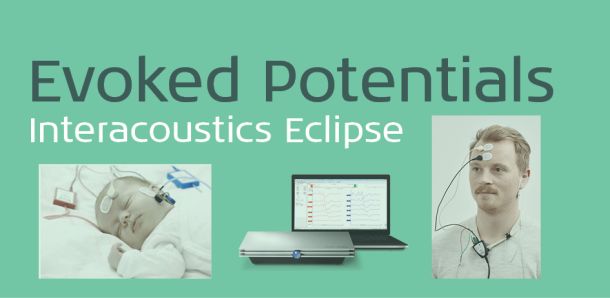
ASSR and ABR Comparison on the Eclipse
